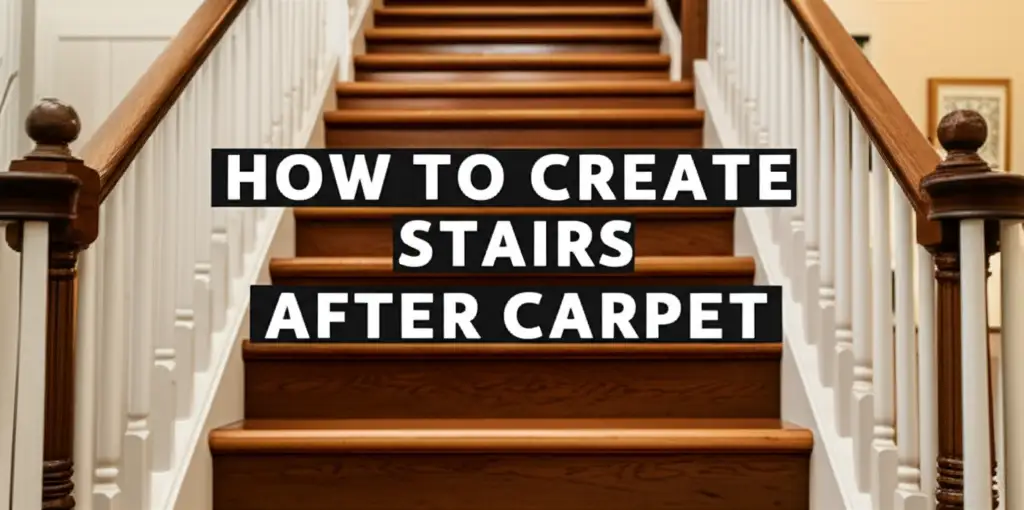· Liora Benning · Home Improvement, DIY · 14 min read
How To Rip Up Carpet And Paint Stairs

How To Rip Up Carpet And Paint Stairs for a Fresh Look
Ready for a big change in your home? Transforming your staircase by removing old carpet and painting the stairs offers a dramatic, fresh look. This DIY project can seem daunting at first. However, with the right steps and tools, you can achieve professional results. I will walk you through each part of this process. We will cover everything from safely removing the carpet to applying a durable paint finish.
Takeaway:
- Gather essential tools for a smooth process.
- Remove carpet and its underlay with care.
- Prepare the wood surface thoroughly by cleaning, sanding, and filling.
- Apply primer and paint using the correct techniques.
- Allow proper curing time for lasting durability.
Ripping up carpet and painting stairs involves several key steps. You must first clear the old carpet and padding from the staircase. Then, you need to prepare the exposed wood by cleaning, sanding, and filling any imperfections. Finally, apply a suitable primer and several coats of durable paint to achieve a beautiful, lasting finish.
Why Transform Your Stairs? The Benefits of Removing Carpet and Painting
Stairs are a central feature in many homes. Old, worn carpet on stairs can make a house feel dated and unclean. Removing this carpet opens up possibilities for a brighter, more modern look. Painting stairs offers a clean, updated aesthetic. This change also makes your stairs easier to clean.
Painted stairs do not trap dust, allergens, or pet dander like carpet does. This improves air quality in your home. Hard surfaces are much simpler to wipe down. They only need a quick sweep or damp mop. Painted stairs also offer a more contemporary design. They can match various decor styles, from classic to modern.
Many homeowners choose to paint their stairs to reveal hidden hardwood. Often, old carpet covers beautiful, solid wood treads. Giving these treads a fresh coat of paint breathes new life into them. It saves money compared to replacing the entire staircase. This project adds value and appeal to your home. It creates a stunning focal point.
Consider the visual impact a freshly painted staircase can have. It draws the eye upwards. It creates an open and airy feeling in your entryway. This transformation can be a significant upgrade for your living space. It makes your home feel new again without major construction. You gain a durable surface that stands up to daily wear.
Gather Your Tools: Essential Equipment for Carpet Removal
Before you begin to rip up carpet, collect all necessary tools. Having everything ready saves time and frustration. Safety gear is crucial for this step. You need good gloves to protect your hands from staples and sharp edges. Safety glasses shield your eyes from debris.
For the actual carpet removal, you will need a utility knife. This helps cut the carpet into manageable strips. A sturdy pry bar or claw hammer is essential. These tools help lift tack strips and staples. Pliers are also useful for pulling out stubborn staples. A floor scraper or a stiff putty knife helps remove adhesive and padding remnants.
You will also need a heavy-duty trash bags or a large tarp. These help contain the removed carpet and padding. A shop vacuum is excellent for cleaning up dust and debris. This project creates a surprising amount of dirt. Having the right tools makes the job safer and more efficient. Do not underestimate the need for good lighting.
- Safety Gear:
- Work gloves
- Safety glasses
- Dust mask
- Cutting Tools:
- Utility knife with extra blades
- Prying and Pulling Tools:
- Pry bar (small and large)
- Claw hammer
- Pliers (locking or vice grips are good)
- Staple remover (a flathead screwdriver can work in a pinch)
- Cleaning and Containment:
- Heavy-duty trash bags or large tarp
- Shop vacuum
Having these tools ready prevents delays. It ensures you can work continuously. This setup makes the carpet removal process much smoother. Remember, quality tools make tough jobs easier. If you are struggling with removing any carpet, consider reading about alternatives like how to cover ugly carpet on stairs to see if that method is a better fit for your situation before you begin.
Step-by-Step Carpet Removal: Safely Stripping Your Stairs
Removing carpet from stairs requires a systematic approach. Start at the top of the staircase. Use your utility knife to cut the carpet down the center of each tread and riser. Cut the carpet into strips about 1-2 feet wide. This makes the pieces easier to handle. Be careful not to cut into the wood underneath.
Once the carpet is cut, begin prying up one edge. Use pliers or a pry bar to grip the carpet. Pull it away from the tack strips. Tack strips are thin pieces of wood with sharp nails. They hold the carpet in place. As you remove the carpet, the padding will come up too. Roll up the removed carpet and padding as you go. This keeps your workspace clear.
After the carpet and padding are gone, you will find the tack strips. Use your pry bar and hammer to gently lift each tack strip. Work carefully to avoid damaging the wood underneath. Many small nails will hold the tack strips. Once all strips are removed, focus on the remaining staples. Pliers or a flathead screwdriver are perfect for pulling out staples one by one. This is often the most time-consuming part of the job.
- Cut Carpet:
- Use a utility knife to cut carpet down the middle of treads and risers.
- Create manageable strips, about 1-2 feet wide.
- Remove Carpet and Padding:
- Start at the top stair.
- Pull carpet and padding away from tack strips.
- Roll up removed materials for easy disposal.
- Remove Tack Strips:
- Use a pry bar and hammer to lift tack strips carefully.
- Work slowly to prevent damage to the wood.
- Extract Staples:
- Use pliers or a flathead screwdriver to pull out every staple.
- Inspect each tread and riser thoroughly for missed staples.
This detailed process ensures all components of the old carpet are gone. It leaves a clean, bare wood surface. This surface is ready for the next stage of preparation. For general tips on carpet removal, some of the techniques used to how to take the carpet out of tile floor can offer broader insights into pulling up carpet.
Preparing Your Stairs for Paint: Cleaning, Repairing, and Sanding
Proper preparation is the most critical step for a successful paint job. After removing all carpet, padding, tack strips, and staples, you must clean the stairs. Use a shop vacuum to pick up all loose dirt and debris. Then, clean the entire surface with a degreaser or a mild soap solution. This removes any grime, oils, or residue left from the carpet adhesive. Let the stairs dry completely before moving on.
Next, inspect the wood for damage. Look for holes from nails and staples. Fill these holes with wood putty or spackle. For larger imperfections or gouges, use wood filler. Apply the filler according to product instructions. Let it dry thoroughly. If you have any stubborn adhesive residue, a scraping tool or mineral spirits can help remove it. Ensure the surface is smooth and clean.
Sanding is essential for paint adhesion. Start with a medium-grit sandpaper (around 80-100 grit) to smooth out any rough spots or raised wood grain. Use a hand sander for flat treads and a sanding sponge for curved nosings and risers. Follow up with a finer-grit sandpaper (120-150 grit) for a smoother finish. Sanding helps the primer and paint stick better. It also creates a more uniform appearance.
- Thorough Cleaning:
- Vacuum all loose debris.
- Wash stairs with a degreaser or mild soap.
- Allow stairs to dry completely.
- Repair Imperfections:
- Fill all nail and staple holes with wood putty.
- Use wood filler for larger gouges.
- Remove any lingering adhesive residue.
- Sanding for Smoothness:
- Begin with 80-100 grit sandpaper for initial smoothing.
- Switch to 120-150 grit sandpaper for a fine finish.
- Wipe down dust with a tack cloth or damp rag after sanding.
After sanding, vacuum the stairs again. Then wipe them down with a tack cloth. This removes all sanding dust. Dust can ruin a paint job. A clean, smooth surface ensures paint adheres well and looks professional. This detailed prep work might seem extensive, but it truly makes all the difference in the final outcome.
Priming and Painting Your Stairs: Achieving a Durable Finish
Once your stairs are clean, repaired, and sanded, they are ready for primer. Priming is a crucial step for painted stairs. It helps the topcoat adhere better. Primer also blocks stains and provides a uniform base. Use a high-quality, oil-based primer for wood stairs. Oil-based primers offer superior adhesion and stain blocking. Apply one to two coats of primer, following the manufacturer’s drying times.
When priming and painting, decide your strategy for using the stairs. You can paint every other stair. This allows you to use the unpainted stairs while the others dry. Once the first set is dry, paint the remaining stairs. Or, if you have another access point, paint all stairs at once. This method provides the best, most even finish. It avoids disrupting the drying process.
Choose a durable paint specifically designed for floors or high-traffic areas. Alkyd (oil-based) paints are very durable but have a longer drying time and strong odor. Water-based acrylic-urethane or epoxy paints are good alternatives. They dry faster and are easier to clean up. Select a semi-gloss or high-gloss finish. These finishes are more durable and easier to clean than flat paints. Apply at least two to three thin coats of paint.
- Apply Primer:
- Use a high-quality, oil-based primer for best adhesion.
- Apply one to two thin, even coats.
- Allow ample drying time between coats.
- Painting Strategy:
- Option 1: Paint every other stair to maintain access.
- Option 2: Paint all stairs at once if alternative access is available.
- Choose Durable Paint:
- Select paint designed for floors or high-traffic areas.
- Consider alkyd, acrylic-urethane, or epoxy-based options.
- Opt for a semi-gloss or high-gloss finish for durability and easy cleaning.
- Application:
- Apply two to three thin coats of paint.
- Use a high-quality brush for edges and a small roller for flat surfaces.
- Maintain wet edges to prevent lap marks.
Remember to follow drying times between coats. Rushing this step can lead to a less durable finish. If you happen to spill paint on existing carpet during this process, knowing what gets paint out of carpet can be incredibly helpful for quick cleanup. Patience here ensures a beautiful and long-lasting result for your painted stairs.
Finishing Touches and Curing: Protecting Your Newly Painted Stairs
After applying the final coat of paint, the work is not quite done. Proper curing is vital for durability. Paint may feel dry to the touch within a few hours. However, it takes days or even weeks to fully cure. During this curing period, the paint hardens and reaches its maximum durability. Avoid heavy foot traffic on the stairs for at least 24-48 hours after the last coat. For best results, wait several days before placing rugs or furniture on them.
To add extra protection and extend the life of your painted stairs, consider applying a clear topcoat. A water-based polyurethane or polycrylic is an excellent choice. These products add a durable, scuff-resistant layer. Polycrylic is non-yellowing, which is great for light-colored paints. Apply two to three thin coats of the clear protector. Lightly sand with very fine grit sandpaper (220 grit or higher) between coats. This creates a super smooth finish.
When applying topcoats, ensure the area is well-ventilated. Follow the manufacturer’s instructions for drying and recoating times. This protective layer is especially important for stairs. They experience constant wear. It helps prevent chips and scratches. It also makes the surface even easier to clean.
- Allow Adequate Curing:
- Paint needs days to weeks to fully harden, not just feel dry.
- Minimize foot traffic for 24-48 hours after final coat.
- Avoid placing rugs or heavy items for several days.
- Apply a Clear Protective Topcoat:
- Use a water-based polyurethane or polycrylic.
- Apply two to three thin coats for maximum protection.
- Lightly sand between coats with fine-grit sandpaper (220+).
- Ventilation and Adherence:
- Ensure good ventilation during application.
- Always follow product-specific drying and recoating instructions.
This final step truly seals the deal on your stair transformation. It provides a tough, beautiful finish that will stand up to years of use. Your newly painted stairs will be a focal point in your home. They will offer both beauty and practical durability.
Troubleshooting Common Issues and Maintenance Tips
Even with careful planning, some issues can arise. If you find stubborn adhesive residue after carpet removal, try a citrus-based adhesive remover or mineral spirits. Apply it, let it sit, then scrape gently. Always test in an inconspicuous area first. For paint drips or uneven spots, wait until the paint is dry. Then, gently sand the area smooth and reapply a thin coat. Patience is key when correcting mistakes.
Maintaining your newly painted stairs is simple. Regular cleaning will keep them looking fresh. Sweep or vacuum them often to remove dirt and grit. Grit acts like sandpaper and can scratch the finish. For deeper cleaning, use a damp cloth with a mild soap solution. Avoid harsh chemical cleaners. These can dull or damage the paint finish over time.
Periodically inspect your stairs for wear and tear. High-traffic areas might show signs of wear sooner. Touch up any chips or scratches promptly. This prevents further damage and keeps your stairs looking their best. Always keep a small can of your exact paint color for touch-ups. Small repairs are much easier than a full repaint.
- Troubleshooting:
- Stubborn Adhesive: Use citrus-based removers or mineral spirits; test first.
- Paint Drips/Unevenness: Sand gently when dry, then reapply a thin coat.
- Maintenance Tips:
- Regular Cleaning: Sweep or vacuum frequently to remove grit.
- Washing: Use a damp cloth with mild soap for deeper cleaning.
- Avoid Harsh Cleaners: They can damage the paint finish.
- Prompt Touch-Ups: Keep leftover paint for quick repairs of chips or scratches.
By following these tips, your painted stairs will remain beautiful and durable for many years. Regular maintenance extends their lifespan. It keeps them looking like new. Enjoy the fresh, clean look of your transformed staircase.
FAQ Section
How long does it take to rip up carpet and paint stairs?
The entire process usually takes 3 to 5 days. Carpet removal can be done in a few hours. Preparation, including cleaning, repairing, and sanding, takes the longest. Painting involves multiple coats and drying times, which extend the project. Patience with drying ensures a durable finish.
What kind of paint is best for stairs?
The best paint for stairs is a durable, high-traffic floor paint. Alkyd (oil-based) paints offer excellent hardness but dry slowly. Water-based acrylic-urethane or epoxy paints are good alternatives. They provide strong durability with faster drying times. Choose a semi-gloss or high-gloss finish for easy cleaning and resistance to scuffs.
Can I paint plywood stairs, or do they need to be hardwood?
Yes, you can paint plywood stairs. Plywood stairs require thorough preparation to look good. This includes filling all seams and imperfections with wood filler. Sanding extensively is also crucial. After proper preparation, plywood can take paint well. Apply a good quality primer designed for wood.
How do I deal with sticky residue after removing carpet?
Sticky residue often remains after carpet removal. You can use a floor scraper to carefully scrape off larger globs. For smaller or persistent residue, apply a citrus-based adhesive remover or mineral spirits. Let it sit for a few minutes. Then, scrub with a stiff brush and wipe clean. Always ensure proper ventilation.
Do I need to prime my stairs before painting?
Yes, priming your stairs is highly recommended. Primer creates a bond between the wood and the paint. It helps the paint adhere better and last longer. Primer also blocks stains from old adhesives or wood tannins. It provides a uniform surface for the topcoat, ensuring a smoother, more consistent finish.
How can I make my painted stairs less slippery?
To make painted stairs less slippery, you can add an anti-slip additive to the final coat of paint or clear topcoat. These additives are fine grit materials that create texture. Another option is to apply anti-slip strips or treads after the paint has fully cured. You can also paint a pattern or runner in a contrasting color for added grip.
Conclusion
Transforming your staircase by learning how to rip up carpet and paint stairs is a rewarding DIY project. It brings a significant update to your home’s look and feel. We have covered every essential step, from gathering tools to applying the final protective coat. Remember, preparation is key for a lasting, beautiful finish. Patience during drying times will also ensure the best results.
This project enhances your home’s aesthetic appeal and increases its value. You now have a clean, modern, and easy-to-maintain staircase. Take pride in your newly updated stairs. They stand as a testament to your hard work and vision. Ready to start your own stair transformation? Grab your tools and begin this exciting home improvement journey today!





